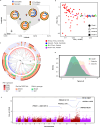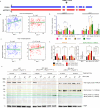Population genomics and transcriptomics of Plasmodium falciparum in Cambodia and Vietnam uncover key components of the artemisinin resistance genetic background
- PMID: 39639029
- PMCID: PMC11621345
- DOI: 10.1038/s41467-024-54915-6
Population genomics and transcriptomics of Plasmodium falciparum in Cambodia and Vietnam uncover key components of the artemisinin resistance genetic background
Abstract
The emergence of Plasmodium falciparum parasites resistant to artemisinins compromises the efficacy of Artemisinin Combination Therapies (ACTs), the global first-line malaria treatment. Artemisinin resistance is a complex genetic trait in which nonsynonymous SNPs in PfK13 cooperate with other genetic variations. Here, we present population genomic/transcriptomic analyses of P. falciparum collected from patients with uncomplicated malaria in Cambodia and Vietnam between 2018 and 2020. Besides the PfK13 SNPs, several polymorphisms, including nonsynonymous SNPs (N1131I and N821K) in PfRad5 and an intronic SNP in PfWD11 (WD40 repeat-containing protein on chromosome 11), appear to be associated with artemisinin resistance, possibly as new markers. There is also a defined set of genes whose steady-state levels of mRNA and/or splice variants or antisense transcripts correlate with artemisinin resistance at the base level. In vivo transcriptional responses to artemisinins indicate the resistant parasite's capacity to decelerate its intraerythrocytic developmental cycle (IDC), which can contribute to the resistant phenotype. During this response, PfRAD5 and PfWD11 upregulate their respective alternatively/aberrantly spliced isoforms, suggesting their contribution to the protective response to artemisinins. PfRAD5 and PfWD11 appear under selective pressure in the Greater Mekong Sub-region over the last decade, suggesting their role in the genetic background of the artemisinin resistance.
© 2024. The Author(s).
Conflict of interest statement
Competing interests: The authors declare no competing interests.
Figures





References
-
- Noedl, H. et al. Evidence of artemisinin-resistant malaria in western Cambodia. N. Engl. J. Med359, 2619–2620 (2008). - PubMed
Publication types
MeSH terms
Substances
Associated data
- Actions
- SRA/PRJNA1011501
LinkOut - more resources
Full Text Sources
Molecular Biology Databases

